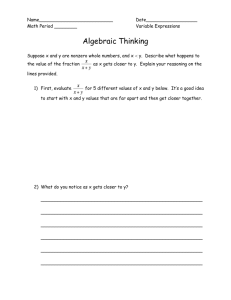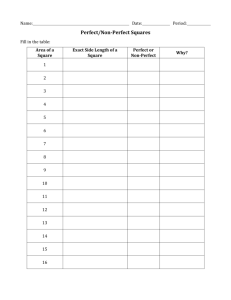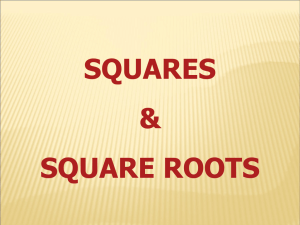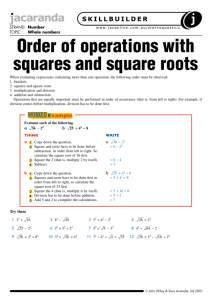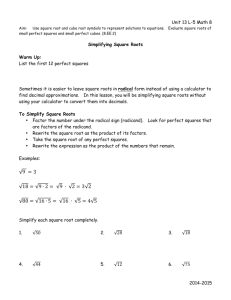1.2 Square Roots of NON-Perfect Squares-Solutions
advertisement
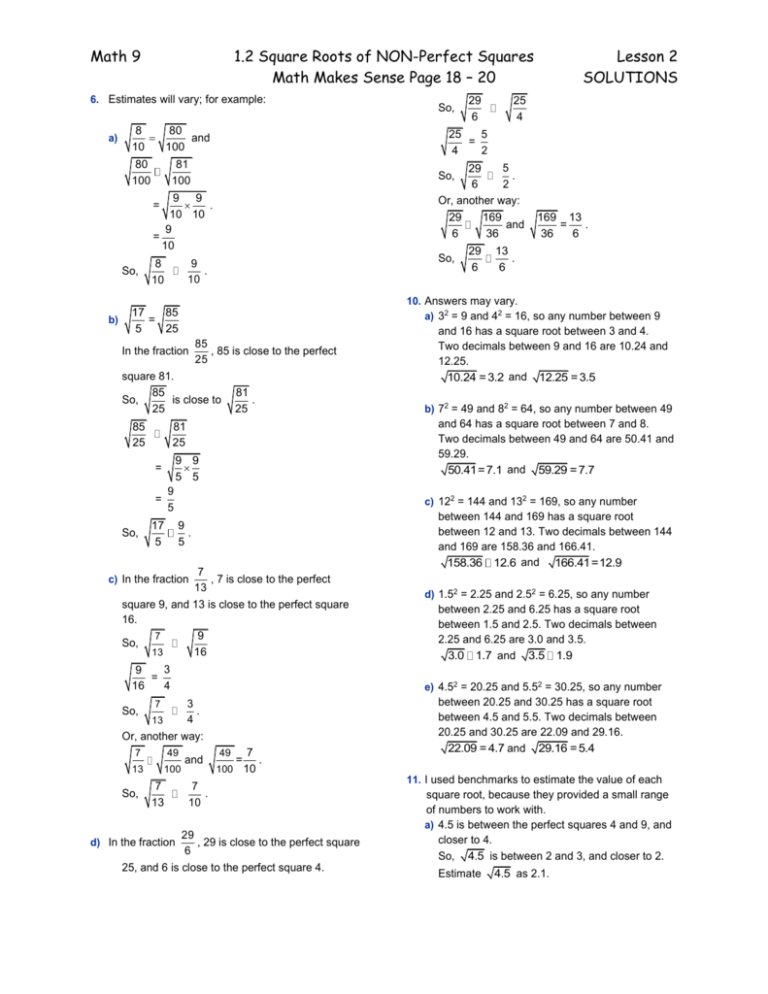
Math 9 1.2 Square Roots of NON-Perfect Squares Math Makes Sense Page 18 – 20 6. Estimates will vary; for example: a) 8 80 and 10 100 80 100 5 29 . 2 6 Or, another way: 29 169 and 6 36 9 9 . 10 10 9 = 10 b) So, 9 . 10 85 In the fraction , 85 is close to the perfect 25 square 81. 85 81 So, is close to . 25 25 9 9 5 5 9 5 = So, 17 5 13 . 6 and 16 has a square root between 3 and 4. Two decimals between 9 and 16 are 10.24 and 12.25. 10.24 = 3.2 and 12.25 = 3.5 b) 72 = 49 and 82 = 64, so any number between 49 and 64 has a square root between 7 and 8. Two decimals between 49 and 64 are 50.41 and 59.29. 50.41= 7.1 and 59.29 = 7.7 81 25 = 29 6 169 13 . = 36 6 10. Answers may vary. a) 32 = 9 and 42 = 16, so any number between 9 17 85 = 5 25 85 25 25 4 So, = So, 29 6 5 25 = 2 4 81 100 8 10 So, Lesson 2 SOLUTIONS c) 122 = 144 and 132 = 169, so any number 9 . 5 7 , 7 is close to the perfect 13 square 9, and 13 is close to the perfect square 16. 7 9 So, 13 16 between 144 and 169 has a square root between 12 and 13. Two decimals between 144 and 169 are 158.36 and 166.41. 158.36 12.6 and 166.41 =12.9 c) In the fraction 3 9 = 4 16 7 7 13 So, 49 100 7 13 and 7 . 100 10 49 between 20.25 and 30.25 has a square root between 4.5 and 5.5. Two decimals between 20.25 and 30.25 are 22.09 and 29.16. 22.09 = 4.7 and 29.16 = 5.4 = 7 . 10 29 , 29 is close to the perfect square 6 25, and 6 is close to the perfect square 4. d) In the fraction between 2.25 and 6.25 has a square root between 1.5 and 2.5. Two decimals between 2.25 and 6.25 are 3.0 and 3.5. 3.0 1.7 and 3.5 1.9 e) 4.52 = 20.25 and 5.52 = 30.25, so any number 3 . 4 13 Or, another way: So, d) 1.52 = 2.25 and 2.52 = 6.25, so any number 11. I used benchmarks to estimate the value of each square root, because they provided a small range of numbers to work with. a) 4.5 is between the perfect squares 4 and 9, and closer to 4. So, 4.5 is between 2 and 3, and closer to 2. Estimate 4.5 as 2.1. Math 9 1.2 Square Roots of NON-Perfect Squares Math Makes Sense Page 18 – 20 To check, evaluate: 2.12 = 4.41 This is very close to 4.5, so 4.5 2.1 . 17 b) = 8.5 2 8.5 is between the perfect squares 4 and 9, and closer to 9. 17 So, is between 2 and 3, and closer to 3. 2 17 as 2.9. 2 To check, evaluate: 2.92 = 8.41, which is very close to 8.5. 17 2.9 So, 2 Estimate c) 0.15 is between the perfect squares 0.09 and 0.16, and closer to 0.16. So, 0.15 is between 0.3 and 0.4, and closer to 0.4. Estimate 0.15 as 0.39. To check, evaluate: 0.392 = 0.1521, which is very close to 0.15. So, 0.15 0.39 10 d) In the fraction , 10 is close to the perfect 41 square 9, and 41 is close to the perfect square 36. 10 9 So, 36 41 3 1 9 = , or 6 2 36 So, 10 41 1 , or 0.5 2 3 9 = 7 49 So, 0.81, and closer to 0.64. So, 0.7 is between 0.8 and 0.9, and closer to 0.8. Estimate 0.7 as 0.84. To check, evaluate: 0.842 = 0.7056, which is very close to 0.7. So, 0.7 0.84 8 , 8 is close to the perfect 45 square 9, and 45 is close to the perfect square 49. 8 9 So, 45 49 f) In the fraction 8 45 3 , or about 0.4 7 g) 0.05 is between the perfect squares 0.04 and 0.09, and closer to 0.04. So, 0.05 is between 0.2 and 0.3, and closer to 0.2. Estimate 0.05 as 0.22. To check, evaluate: 0.222 = 0.0484, which is very close to 0.05. So, 0.05 0.22 90 , 90 is close to the perfect 19 square 81, and 19 is close to the perfect square 16. 90 81 So, 19 16 h) In the fraction 9 81 = 4 16 So, 90 19 9 4 12. Estimates may vary. I used benchmarks. 3 a) In the fraction , 3 is close to the perfect square 8 4, and 8 is close to the perfect square 9. 3 4 So, 8 9 2 4 = 3 9 3 8 2 , or about 0.7 to the nearest tenth 3 5 b) In the fraction , 5 is close to the perfect 12 square 4, and 12 is close to the perfect square 9. 5 4 So, 12 9 So, e) 0.7 is between the perfect squares 0.64 and Lesson 2 SOLUTIONS 2 4 = 3 9 So, 5 12 2 , or about 0.7 to the nearest tenth 3 13 , 13 is close to the perfect 4 square 16, and 4 is a perfect square. c) In the fraction Math 9 So, 1.2 Square Roots of NON-Perfect Squares Math Makes Sense Page 18 – 20 13 4 16 4 18. a) The numbers greater than 1 have square roots that are less than the given number. For example: 2 1.4142, 4 = 2, 16 =2 4 So, 13 4 3.1623, 2.0 10 100 = 10 b) The number must be 0 or 1 for its square root to be equal to the number. 0 = 0, 1 = 1 d) I wrote the fraction as a decimal, then used benchmarks. 25 8.3 3 The closest perfect squares on either side of 8.3 are 4 and 9. 4 = 2 and 9 = 3 8.3 is closer to 9, so choose 2.9 as a possible estimate for a square root. To check, evaluate: 2.92 = 8.41, which is close to 8.3. 25 2 .9 So, 3 Lesson 2 SOLUTIONS c) The numbers less than 1 have square roots that are greater than the given number. For example: 0.1 0.3162, 0.01 = 0.1, 0.09 = 0.3, 0.1581 0.025 19. Answers will vary. For example: a) The number with a square root of 1 is 1. So, any number between 0 and 1 has a square root between 0 and 1. For example: 0.64 0.64 is between 0 and 1. b) The number with a square root of 1.5 is 2.25. The number with a square root of 2 is 4. So, any number between 2.25 and 4 has a square root between 1.5 and 2. For example: 3 3 1.7321 is between 1.5 and 2. 13. Write the Pythagorean Theorem in each right triangle to determine the unknown length. a) h2 = 1.22 + 0.52 = 1.44 + 0.25 = 1.69 h = 1.69 = 1.3 The unknown length h is 1.3 cm. b) h2 = 1.52 + 2.22 = 2.25 + 4.84 = 7.09 h = 7.09 2.663 The unknown length h is about 2.7 cm. s2 2.82 1 2 = 0.5 and = 0.7 The unknown length s is 0.7 cm. 3 4 1 2 and 3 4 as decimals: = 0.75 The number with a square root of 0.5 is 0.25. The number with a square root of 0.75 is 0.5625. So, any number between 0.25 and 0.5625 has a square root between 1 and 3 . 2 For example: 0.4, or 5.62 + = s2 = 5.62 – 2.82 = 31.36 – 7.84 = 23.52 s = 23.52 4.85 The unknown length s is about 4.9 cm. d) s2 + 2.42 = 2.52 s2 = 2.52 – 2.42 = 6.25 –5.76 = 0.49 s = 0.49 c) Write c) 0.4 So, 4 4 10 4 10 0.63 0.4 is between d) Write 3 1 2 and 3 4 3 as a decimal: 4 3 = 3.75 4 The number with a square root of 3.75 is 14.0625. The number with a square root of 4 is 16. So, any number between 14.0625 and 16 has a 3 Math 9 1.2 Square Roots of NON-Perfect Squares Math Makes Sense Page 18 – 20 square root between 3 3 and 5. 4 For example: 15 15 3.873 is between 3 3 and 4. 4 20. a) AB2 = 0.52 + 1.752 = 0.25 + 3.0625 = 3.3125 AB = 3.3125 1.82 AB is about 1.82 km. b) AB2 = 1.252 + 22 = 1.5625 + 4 = 5.5625 AB = 5.5625 2.3585 AB is about 2.36 km 22. 0.6 0.775 and 0.61 0.781 So, all numbers between 0.775 and 0.781 have squares between 0.6 and 0.61. For example: 0.7762 0.6022, 0.7792 0.6068, and 0.782 = 0.6084, which are all between 0.6 and 0.61. 23. The square has area 0.25 square units. Take the square root of its area to determine the side length. 0.25 = 0.5 So, the side length of the square is 0.5 units. The scale is 1 grid square represents 0.1 units. So, 0.5 units represent 5 grid squares. Since one vertex of the square is (1.1, 0.7), the other vertices of one possible square are: (1.1, 0.2), (0.6, 0.2), and (0.6, 0.7). Lesson 2 SOLUTIONS It is possible to get other vertices by considering different positions of the square: (1.1, 0.2), (1.6, 0.2), and (1.6, 0.7) or (1.6, 0.7), (1.6, 1.2), and (1.1, 1.2) or (1.1, 1.2), (0.6, 1.2), and (0.6, 0.7). 24. a) The area of the original photograph, in square centimetres, is (5.5)2, or 30.25 cm2. The area of the larger photograph is: 30.25 cm2 2 = 60.5 cm2 To determine the side length of the square, take the square root of the area of the square: 60.5 7.8 So, the side length of the larger photograph is approximately 7.8 cm. b) For example, a square with side length 5.5 cm has an area of (5.5)2, or 30.25 cm2. Double the side length of the square: 5.5 cm 2 = 11 cm A square with side length 11 cm has an area of (11)2, or 121 cm2, which is 30.25 cm2 4. So, doubling the side length of a square does not double the area; it increases the area by a factor of 4.

